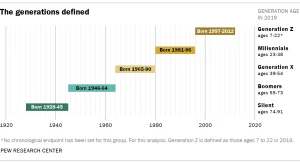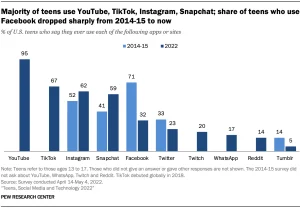The Benefits of Investing in B2B Paid Review Sites Like Gartner’s Digital Market
It’s no secret that reviews are pivotal to the success of your business, regardless of the industry. Whether you are shopping for a birthday gift on Amazon or looking for a design team to revamp your company’s website, reviews are paramount in influencing a purchase.
In 2022, Google released a series of Product Review Updates, designed to prioritize valuable review content and research right within the organic search results. As more review articles enter the SERP, a site’s organic visibility has the potential to drop. And that’s where paid marketing can come into play.
According to Gartner, 71% of B2B buyers start their research with a generic search for products or services, and then explore directories and ranking sites to find the best fit for their needs. It is important for B2B companies to opt into these review site partners like Capterra, GetApp, and Software Advice not only to bolster their SEO presence but also as an alternative lead gen strategy to paid search. Websites like Capterra are exclusive to B2B software solutions and attract visitors who are further down the conversion funnel, since they are comparing software and looking for rankings.
Pay-Per-Click vs. Pay-Per-Lead on Review Sites:
Gartner Digital Market’s Capterra, GetApp, and Software Advice offer both pay-per-click (PPC) and pay-per-lead (PPL) solutions for advertisers through their vendor portals. By upgrading your free basic listing to a paid account, you can opt into “bidding” through the PPC program. Like Google search, PPC programs use max CPC bids to show your Capterra listing across 1,200 different software categories. The higher your bid, the higher your listing will rank across dedicated software category pages. You can then view click, cost, position, and conversion data. You will only be charged when a user clicks off the Capterra domain and onto your landing page. Therefore, you can also improve overall brand awareness and credibility of your site.
The pay-per-lead (PPL) program offers marketers an alternative way to reach the right software customers and generate sales qualified leads. When a user opts into the PPL program through Software Advice, they participate in an overview with a Gartner rep who will work with the team to determine targeted buyer profiles. They can then set max CPC bids, like the PPC program, on the leads they want to purchase. These leads have already been pre-screened by free dedicated sales representatives who are experts in the targeted industry to ensure that the lead best fits the organization’s target customer profile. Once approved, the hot lead is sent to the appropriate sales team for further nurturing.
The Benefits of Investing in Gartner Digital Markets:
Efficient Cost/Lead and CPCs:
In most cases, conversion rates across Gartner Digital Market sites are stronger than Google search, leading to a more efficient cost/lead. This is likely due to the user being more targeted and further down the funnel, looking for a B2B software solution. Consider the data below, from an organization that completely shifted away from Google due to high CPCs within their industry and devoted their full marketing budget to the Capterra PPC program.
Global Reach:
Every month, 9 million highly invested B2B customers visit review sites looking for software solutions. Additionally, listings are available in 60 different countries.
Strong Customer Service:
Once you opt into a paid listing within Gartner Digital Markets, you are linked with a dedicated service representative. These reps are available for phone call meetings, budget projections, optimization recommendations and general consulting needs.
Landing Page Creation:
Gartner’s team of experts offers services to create conversion-optimized landing pages for PPC clients. Depending on the package type, these landing pages can be translated into different languages and will connect with your CRM system to funnel lead volume.
Easy to Manage:
The vendor portal platform within Capterra is easy to use and manage. Bid management for all three sites (Capterra, GetApp, and Software Advice) are located under one view. The bid simulator will give estimated positions which can better help determine bids.
Strong Competitor Insights:
With the help of your rep, you can perform deep-dive competitive analyses to see which competitors have opted into paid listings and which categories they are actively bidding on.
As a lead gen focused agency, we are constantly looking for methods to better improve our lead volume to drive qualified, targeted opportunities for our clients. For more information about review site paid efforts, please contact us by email at sales@synapsesem.com or phone at 781-591-0752.
How the Top Social Platforms are Bending to Gen Z
Move over Millennials, Gen Z is calling the shots now. They may be young, and their purchasing power has yet to be truly defined, but they are changing the online landscape, quickly.
Who is Gen Z? What recent changes to LinkedIn, Meta, and even Google have they influenced at their young age? We’ll cover all of that, so when you are asked, “What is TikTok all about?” or “How can we expand our followers to the younger generation?”, you’ll know the answers.
How Gen Z is Defined
The youngest defined generation to date is currently between the ages of 7-25, per the Research Center. This generation is uniquely different from prior ones, as the internet, connectivity, and social media have been a part of their lives from the start. Nicknamed the “digital natives,” the digital world is as common to them, as the TV was for the Millennial Generation.
 They may be young, but they are large. Gen Z makes up 30% of the total global population and is the largest generation in American history, with the older members of the group now entering the workforce. Clearly a force for all businesses to become familiar with.
They may be young, but they are large. Gen Z makes up 30% of the total global population and is the largest generation in American history, with the older members of the group now entering the workforce. Clearly a force for all businesses to become familiar with.
The World Economic Forum indicates that Gen Z will make up 27% of the global workforce by 2025.
Gen Z’s Influence on the Social Media Landscape
Overall, social media usage is on the rise and steadily growing, with an estimated 60% of the world population active on social media. However, when Gen Z entered the landscape, the social media behemoths (Facebook, Twitter, Instagram) were quickly rejected. Acutely aware of how their social presence impacts their lives, and tired of the toxicity that “likes” create, Gen Z has opted for a different type of online experience.
But why are the established platforms changing their product now? With apps like TikTok, WhatsApp, and YouTube surging amongst this audience, competition is fierce to gain the attention of this audience. Here are the key ways in which Generation Z is changing the media landscape:
- Short videos are king.
TikTok exploded with the help of Gen Z due to its algorithm, which keeps users coming back for the content it knows they like. Gen Z spends 24-48 hours per month on TikTok (Pew Research) watching videos, as 61% of Gen Z prefer short videos (under 1 minute). Remember when Twitter tried short-form? Neither can we, because it was quickly pulled, but you might remember the term “fleet.” The larger platforms have not given up, however. Instagram and YouTube are still trying to compete with Reels and Shorts, respectively—in efforts to attract the Gen Z audience.
- No filters please.
In September 2022, BeReal, an app that asks users to post an unfiltered photo of themselves once a day, was the most downloaded social media app (Statista). Authenticity has always been key to success on social media. Gen Z has found that the older platforms, specifically Twitter and Facebook, no longer offer that authentic experience with their algorithm focusing more on engagement. Just launched in 2020, BeReal is capturing the no filter, be yourself philosophy of Gen Z. To combat this preference, Instagram is testing IG Candid Challenges, which offer the same prompts to share a candid photo each day.
- Make shopping easy.
97% of Gen Z Consumers (Forbes) use social media as their top source of shopping inspiration. The hashtag #Tiktokmademebuy has over 4.7 billion views, #amazonfinds has more than 6.7 billion views, and #booktok, with over 78 billion views, helped make 2021 one of the publishing industry’s best sales years ever. With Gen Z leaning toward seamless checkout experiences, Instagram updated its shopping experience with swipe-ups that take a user directly to the product. Facebook, Instagram, and Pinterest are also expanding their 3rd party partnerships with companies like Shopify to ensure fast and secure transactions.
How Gen Z Is Changing Google Search
Google is also feeling the pressure, with 40% of Gen Z using TikTok for search instead of Google. This is an amazing stat, which Google confirmed during a recent event on how their products and services are changing. The queries that brands have historically seen are not the queries of Gen Z. Here are the recent changes Google will be rolling out to their products, to meet the demands of more visually rich experiences, intended to lure Gen Z back (Google Search On 2022).
- Google Maps is now incorporating augmented reality, to meet the younger generation’s visually rich requests.
- Search has been updated to make the experience even more natural with multi-search, allowing users to now search using images and text. Lens, which Google launched in 2017, answers 8 billion questions every month.
- With 83% of Gen Z shopping on social media, Google added 9 features and tools to make it easier to shop on Google, including more visual ways to shop.
- YouTube Shorts, which was launched to directly compete with TikTok in 2021 is gaining ground, watched by over 1.5 billion logged-in users every month.
Knowing a major US company is altering their offerings to lure this generation, it’s important to review your own business strategies and online experiences to ensure you are also meeting the expectations of Gen Z.
How Brands Should Approach Their 2023 Social Media Strategies
With their ever-increasing purchasing power and propensity to impact social issues, Generation Z is one we’ll all want to watch closely. Sprout Social recently conducted a survey to determine what they are expecting from their social media platforms, finding that:
- 64% of Gen Z consumers expect a more personalized experience on social media based on previous interactions.
- 61% of Gen Z consumers want companies to know them better based on their social media activity.
- 52% of Gen Z consumers expect companies to read and analyze their social media posts.
What should brands do now? Though Gen Z is making the biggest splash we’ve seen in a while, they are not the only group to use social media. Every platform offers a unique purpose to each user, regardless of the generation. The key to a brand’s success is to use the platforms appropriately, authentically, and customized to your target audience.
If you are looking to court this new audience, keep these top social media goals in mind for 2023, as they apply to all generations on the platforms:
- Make shopping experiences easy. Utilize the online catalogs and shopping features offered by social media apps today.
- Begin content creator collaborations. A robust library of content, as well as the credibility UGC offers will be a critical component of social media strategies this year.
- Increase video content development. Gen Z has proven that they prefer to watch content.
- Utilizing UGC as well as in-house development should be built into all brands media strategies moving forward. Embrace the smaller and emerging social media platforms. They may be small, but they grow quickly. Brands who are early adapters can hone their message establish themselves as thought leaders on new platforms.
Remember, TikTok did not exist a few years ago, yet it is changing the online landscape we know today. Keep an eye on the smaller and emerging platforms, continue to test, and always keep yourself up to date on all platform changes and new offerings to be able to compete effectively.
Contact us at paul@synapsesem.com if you’d like to subscribe to the Synapse SEM newsletter, or to learn more about our evolving search engine marketing services.





